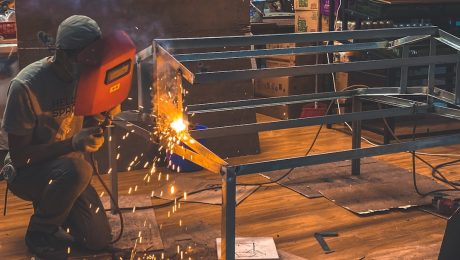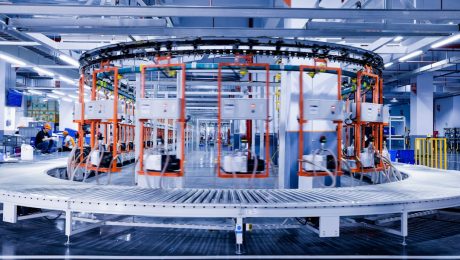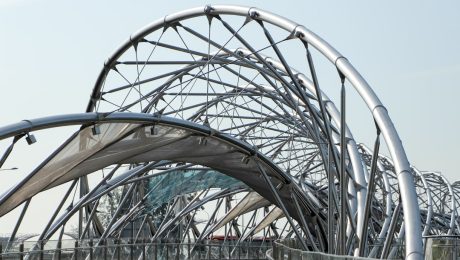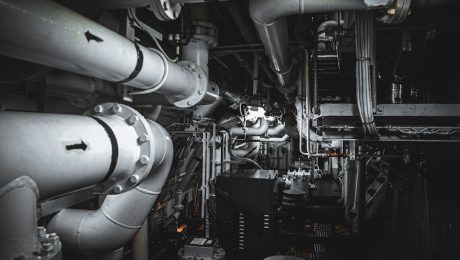Stainless steel, an alloy of iron, chromium, and other elements, has revolutionized various industries due to its exceptional properties. Its resistance to corrosion, strength, and durability make it a preferred material for countless applications. This guide delves into the world of stainless steel, exploring its different grades, applications, maintenance, and more, empowering you to make informed decisions when choosing stainless steel products.
Understanding Stainless Steel Grades: A Deep Dive
The properties of stainless steel vary significantly depending on its grade. These grades are determined by the specific composition of alloying elements, primarily chromium, nickel, molybdenum, and manganese. Common grades include:
- 304 (18/8): This is the most common grade, offering excellent corrosion resistance and workability. It’s widely used in kitchenware, architectural elements, and food processing equipment.
- 316: Containing molybdenum, 316 stainless steel exhibits superior resistance to chloride corrosion, making it ideal for marine environments and medical applications. It’s often found in surgical instruments and coastal structures.
- 430: A ferritic stainless steel, 430 is less expensive than austenitic grades (like 304 and 316) but offers good corrosion resistance in less demanding environments. It’s commonly used in automotive parts and appliances.
- 410: A martensitic stainless steel, 410 is known for its high strength and hardness after heat treatment. It’s often used in cutlery and tools.
Choosing the right grade is crucial for ensuring the longevity and performance of your stainless steel product. Consider the specific application and environmental conditions to select the most appropriate grade.
Diverse Applications of Stainless Steel: From Kitchen to Construction
The versatility of stainless steel is reflected in its wide range of applications across various sectors:
- Food and Beverage Industry: Its resistance to corrosion and ease of cleaning make it perfect for food processing equipment, storage tanks, and kitchenware.
- Medical Industry: Biocompatibility and resistance to sterilization procedures make it a vital material for surgical instruments, implants, and medical equipment.
- Architecture and Construction: Stainless steel is used in building facades, roofing, handrails, and structural components due to its strength, durability, and aesthetic appeal.
- Automotive Industry: It’s used in exhaust systems, body panels, and other components due to its corrosion resistance and high strength-to-weight ratio.
- Chemical Processing: Its resistance to various chemicals makes it suitable for pipes, tanks, and other equipment used in chemical plants.
This diverse applicability showcases stainless steel’s adaptability and its crucial role in modern technologies and infrastructure.
Maintaining Your Stainless Steel Investment: Cleaning and Care
Proper maintenance is key to extending the lifespan of your stainless steel products. Regular cleaning and care can prevent staining, corrosion, and damage. Here are some tips:
- Regular Cleaning: Use a mild detergent and warm water with a soft cloth or sponge. Avoid abrasive cleaners or scouring pads that can scratch the surface.
- Stain Removal: For stubborn stains, a paste of baking soda and water can be effective. For more persistent stains, consult a professional cleaner.
- Preventing Rust: Dry stainless steel surfaces thoroughly after cleaning to prevent water spots and potential rust formation.
- Handling Scratches: Minor scratches can often be buffed out with a fine abrasive polish. Deep scratches may require professional repair.
By following these simple maintenance tips, you can preserve the beauty and functionality of your stainless steel products for years to come.
Choosing the Right Stainless Steel Product: A Buyer’s Guide
Selecting the right stainless steel product involves considering several factors:
- Grade Selection: As discussed earlier, choosing the appropriate grade based on the application is crucial.
- Manufacturer Reputation: Opt for reputable manufacturers who adhere to quality standards and provide warranties.
- Product Specifications: Carefully review the product specifications, including dimensions, weight, and finish.
- Price Comparison: Compare prices from different suppliers, but prioritize quality over price.
- Warranty and Customer Support: A good warranty and responsive customer support demonstrate the manufacturer’s confidence in their product.
Taking these factors into account will ensure that you invest in a high-quality stainless steel product that meets your specific needs and expectations.
The Future of Stainless Steel: Innovations and Sustainability
Research and development continue to push the boundaries of stainless steel technology. Innovations are focusing on:
- Improved corrosion resistance: New alloys are being developed to enhance resistance to even the harshest environments.
- Enhanced strength and durability: Advanced manufacturing techniques are leading to stronger and more durable stainless steel products.
- Sustainability: The industry is increasingly focused on sustainable manufacturing practices, including recycling and reducing energy consumption.
- New applications: Stainless steel is finding its way into new and emerging technologies, such as 3D printing and advanced medical devices.
The future of stainless steel looks bright, with ongoing innovations promising even greater versatility and sustainability in the years to come.
This comprehensive guide provides a solid foundation for understanding and utilizing stainless steel products effectively. Remember to always choose the right grade for your specific application and maintain your stainless steel investment properly to ensure its long-term performance.
The strength and reliability of steel structures, from skyscrapers to bridges to automobiles, depend heavily on the quality of the steel itself. Maintaining consistent and high-quality steel requires rigorous quality control methods throughout the entire production process. This post delves into the key methods used to ensure steel meets the required specifications and performs as expected.
1. Chemical Composition Analysis: The Foundation of Steel Quality
The first crucial step in steel quality control is analyzing its chemical composition. This involves precisely determining the percentages of various elements present, including carbon, manganese, silicon, phosphorus, sulfur, and alloying elements like chromium, nickel, molybdenum, and vanadium. These elements significantly influence the steel’s properties, such as strength, hardness, ductility, and weldability. Different steel grades require specific chemical compositions to achieve their desired characteristics.
Chemical analysis is typically conducted using techniques like:
- Spectroscopy (Optical Emission Spectrometry – OES): A rapid and accurate method that excites atoms in a sample and analyzes the emitted light to determine elemental composition.
- Inductively Coupled Plasma – Atomic Emission Spectrometry (ICP-AES) and Inductively Coupled Plasma – Mass Spectrometry (ICP-MS): Highly sensitive techniques used for trace element analysis, providing precise measurements of even minute impurities.
- Wet Chemical Analysis: Traditional methods involving chemical reactions and titrations, often used for specific element determination or verification.
Precise chemical analysis ensures that the steel meets the required specifications and avoids potential defects stemming from incorrect elemental proportions.
2. Mechanical Testing: Evaluating Steel’s Physical Performance
Chemical composition alone doesn’t fully define a steel’s properties. Mechanical testing is crucial to evaluate its physical performance characteristics under stress and strain. These tests determine parameters like tensile strength, yield strength, elongation, reduction in area, hardness, and impact resistance.
Common mechanical tests include:
- Tensile Testing: Measures the steel’s strength and ductility by applying a controlled tensile force until fracture.
- Hardness Testing: Assesses the steel’s resistance to indentation using methods like Brinell, Rockwell, and Vickers hardness tests.
- Impact Testing (Charpy or Izod): Determines the steel’s resistance to fracture under impact loading, crucial for assessing toughness at low temperatures.
- Bend Testing: Evaluates the steel’s ductility and ability to deform plastically without cracking.
Mechanical testing provides vital data to ensure the steel meets the required strength, toughness, and formability for its intended application.
3. Non-Destructive Testing (NDT): Detecting Hidden Flaws
Non-destructive testing (NDT) methods are essential for detecting internal flaws and defects in steel without damaging the material. These techniques are crucial for ensuring the integrity of finished products and preventing catastrophic failures. Common NDT methods employed in steel quality control include:
- Ultrasonic Testing (UT): Uses high-frequency sound waves to detect internal flaws like cracks, voids, and inclusions.
- Radiographic Testing (RT): Employs X-rays or gamma rays to create images revealing internal defects.
- Magnetic Particle Testing (MT): Detects surface and near-surface cracks in ferromagnetic materials by magnetizing the steel and applying magnetic particles.
- Liquid Penetrant Testing (PT): Identifies surface-breaking flaws by applying a penetrating liquid that seeps into cracks and is then revealed by a developer.
- Eddy Current Testing (ET): Uses electromagnetic induction to detect surface and subsurface flaws in conductive materials.
NDT methods provide a critical safety net, ensuring that defects that might otherwise go unnoticed are identified and addressed.
4. Microstructure Analysis: Unveiling the Steel’s Internal Structure
The microstructure of steel, the arrangement of its constituent phases (ferrite, pearlite, cementite, etc.), significantly influences its mechanical properties. Microstructure analysis involves examining the steel’s internal structure using microscopy techniques. This allows for the identification of phases, grain size, and the presence of inclusions or precipitates.
Techniques used in microstructure analysis include:
- Optical Microscopy: Provides visual examination of the polished and etched steel surface at magnifications up to 1000x.
- Scanning Electron Microscopy (SEM): Offers higher resolution imaging and compositional analysis at much higher magnifications.
- Transmission Electron Microscopy (TEM): Provides the highest resolution imaging, revealing fine details of the microstructure.
Understanding the microstructure ensures that the steel’s processing parameters (heating, cooling rates) have resulted in the desired structure and properties.
5. Statistical Process Control (SPC): Maintaining Consistent Quality
Statistical Process Control (SPC) is a crucial tool for maintaining consistent steel quality over time. SPC employs statistical methods to monitor and control the manufacturing process, identifying and addressing sources of variation before they lead to defects. This involves collecting data on key process parameters and using control charts to track their behavior. Any deviations from established control limits signal potential problems requiring investigation and corrective action.
SPC ensures that the steel production process remains stable and predictable, leading to consistently high-quality products. It helps to identify and eliminate the root causes of variation, thereby minimizing defects and maximizing efficiency.
In conclusion, maintaining steel quality requires a multi-faceted approach involving chemical analysis, mechanical testing, non-destructive testing, microstructure analysis, and statistical process control. By implementing these methods rigorously, manufacturers can ensure the production of high-quality steel that meets stringent specifications and performs reliably in its intended applications.
SEO Tags:
- Steel Quality Control
- Steel Testing Methods
- Metallurgical Testing
- Non-Destructive Testing Steel
- Steel Quality Assurance
body { font-family: sans-serif; line-height: 1.6; }
h1, h2, h3 { color: #333; }
img { max-width: 100%; height: auto; }
Galvanized steel, with its zinc coating, is a popular choice for a wide range of applications due to its exceptional corrosion resistance. But how does this robust material fare in the harsh conditions of cold climates? From icy winters to relentless snow, understanding the performance of galvanized products in freezing temperatures is crucial for ensuring longevity and safety. This comprehensive guide delves into the key aspects of galvanized steel’s performance in cold weather.
Corrosion Resistance in Sub-Zero Temperatures
One of the primary reasons for choosing galvanized steel is its superior corrosion resistance. The zinc coating acts as a sacrificial anode, protecting the underlying steel from rust and degradation. While this protection remains effective in cold climates, it’s important to note that the rate of corrosion can be influenced by factors such as the presence of de-icing salts and the frequency of freeze-thaw cycles. De-icing salts, commonly used on roads and walkways during winter, can accelerate corrosion if they come into prolonged contact with the galvanized surface. The repeated expansion and contraction of the metal during freeze-thaw cycles can also contribute to minor surface damage, potentially exposing the underlying steel. However, the zinc coating provides a significant buffer against these effects, offering substantially better protection than untreated steel. Regular inspection and cleaning, especially after winter, can further enhance the longevity of galvanized products in cold environments.
The Impact of Snow and Ice Removal
The methods used for snow and ice removal can significantly affect the condition of galvanized steel structures. Aggressive scraping or the use of heavy machinery can scratch the zinc coating, compromising its protective barrier. Similarly, the use of harsh chemicals in de-icing agents can accelerate corrosion at any exposed areas. Therefore, careful consideration should be given to snow and ice removal techniques. Gentle brushing or melting ice with warm water are preferable to methods that could damage the surface. If chemical de-icers are necessary, choosing less corrosive options and rinsing the galvanized surfaces afterwards can help mitigate potential damage.
Thermal Bridging and Heat Loss in Cold Climates
Galvanized steel, being a metal, has a higher thermal conductivity than many other building materials. This means that it can transfer heat more readily, leading to potential thermal bridging in cold climates. Thermal bridging occurs when heat escapes from a building through conductive materials like metal, resulting in increased energy consumption and potential cold spots within the structure. While galvanized steel is not as significant a thermal bridge as some other metals, it’s important to consider its thermal properties when designing buildings or structures in cold regions. Using appropriate insulation techniques and incorporating thermal breaks can effectively minimize heat loss through galvanized steel components.
Maintaining Galvanized Steel in Cold Environments
Regular maintenance is crucial for ensuring the long-term performance of galvanized steel in cold climates. This includes regular inspections to identify any signs of damage, such as scratches, rust spots, or areas of exposed steel. Cleaning the surface to remove dirt, debris, and corrosive salts is also essential. A simple water rinse is usually sufficient, but in areas with heavy salt usage, a more thorough cleaning may be necessary. For larger structures, professional inspections and maintenance should be scheduled periodically to ensure early detection and timely repair of any potential problems. Addressing minor issues promptly can prevent them from escalating into more significant and costly repairs down the line.
Choosing the Right Galvanization for Cold Climates
The thickness of the zinc coating plays a crucial role in its performance in cold environments. A thicker coating provides more protection against corrosion and the effects of de-icing salts and freeze-thaw cycles. Different galvanizing processes, such as hot-dip galvanizing and electro-galvanizing, offer varying levels of zinc coating thickness. Hot-dip galvanizing generally provides a thicker, more durable coating, making it a suitable choice for applications in harsh cold climates. When specifying galvanized steel for cold climate applications, it’s essential to consult with a qualified engineer or materials specialist to ensure the selection of a suitable coating thickness and galvanizing process to meet the specific requirements of the project and the expected environmental conditions.
In conclusion, galvanized steel remains a reliable and cost-effective material for a variety of applications even in the most challenging cold climates. By understanding its properties, implementing appropriate maintenance practices, and choosing the right galvanization process, you can ensure the longevity and performance of your galvanized steel products for years to come. Remember that proactive maintenance and careful consideration of environmental factors are key to maximizing the lifespan and effectiveness of galvanized steel in sub-zero temperatures.
SEO Tags:
galvanized steel, cold climate, corrosion resistance, winter maintenance, thermal bridging
body {
font-family: sans-serif;
line-height: 1.6;
}
h1, h2, h3 {
color: #333;
}
img {
max-width: 100%;
height: auto;
}
Scaffolding is an integral part of any construction project, providing a safe and stable working platform for workers at heights. At the heart of most scaffolding systems lie scaffolding pipes – the robust and versatile components that form the backbone of these temporary structures. This comprehensive guide delves into the world of scaffolding pipes, exploring their various types, applications, safety considerations, regulations, and future trends.
Types of Scaffolding Pipes Used in Construction
Scaffolding pipes are typically made from high-strength steel, designed to withstand significant loads and environmental factors. Several types are commonly used, each with its own strengths and weaknesses:
- Standard Scaffolding Pipes: These are the most common type, usually black, galvanized, or powder-coated to prevent corrosion. Their diameter and wall thickness vary depending on the intended load and application.
- Lightweight Scaffolding Pipes: These pipes offer a good balance between strength and weight, making them easier to handle and transport. They are often used in smaller projects or where accessibility is limited.
- Heavy-Duty Scaffolding Pipes: Designed for exceptionally heavy loads and demanding applications, these pipes have thicker walls and higher tensile strength. They are frequently used in large-scale projects or where extreme stability is required.
- Aluminum Scaffolding Pipes: While less common than steel, aluminum pipes offer significant weight advantages, making them suitable for certain applications. However, they may not be as strong as steel pipes and are generally more expensive.
The choice of pipe type depends on factors such as the height of the scaffold, the anticipated load, the environmental conditions, and the overall project requirements.
Applications of Scaffolding Pipes Across Diverse Construction Projects
Scaffolding pipes are incredibly versatile and find applications across a wide range of construction projects, including:
- Building Construction: Providing access for bricklayers, painters, electricians, and other tradespeople working on exterior walls and high-level areas.
- Bridge Construction: Supporting workers and equipment during the construction and maintenance of bridges.
- Industrial Construction: Creating platforms for maintenance and repair work on large industrial structures.
- Renovation Projects: Providing safe access to upper floors and areas during renovations and repairs.
- Event Staging: Constructing temporary platforms and stages for concerts, festivals, and other events.
The adaptability of scaffolding pipes allows for the creation of customized scaffolding systems tailored to the specific needs of each project.
Safety Regulations and Best Practices for Scaffolding Pipe Usage
The safe use of scaffolding pipes is paramount. Strict adherence to safety regulations and best practices is essential to prevent accidents. These include:
- Regular Inspections: Thorough inspections of scaffolding pipes and fittings should be conducted before, during, and after use to identify any damage or defects.
- Proper Erection and Dismantling: Scaffolding should be erected and dismantled by trained and competent personnel following established procedures.
- Load Capacity: The scaffolding system must be designed and constructed to support the anticipated load, taking into account the weight of workers, materials, and equipment.
- Fall Protection: Appropriate fall protection measures, such as guardrails, toe boards, and safety nets, should be implemented to protect workers from falls.
- Compliance with Regulations: All scaffolding must comply with relevant national and local safety regulations and standards.
Negligence in safety procedures can lead to serious injuries or fatalities. Prioritizing safety is crucial throughout the entire scaffolding lifecycle.
Maintaining and Extending the Lifespan of Scaffolding Pipes
Proper maintenance significantly extends the lifespan of scaffolding pipes and ensures their continued safety and reliability. Key maintenance practices include:
- Regular Cleaning: Removing dirt, debris, and corrosion from pipes helps prevent damage and extends their service life.
- Corrosion Protection: Applying protective coatings, such as paint or galvanizing, can significantly improve the resistance of pipes to corrosion.
- Damage Repair: Damaged pipes should be repaired or replaced immediately to prevent accidents.
- Proper Storage: Scaffolding pipes should be stored in a dry, protected area to prevent corrosion and damage.
- Regular Inspections: Routine inspections can identify potential issues before they become serious problems.
Investing in proper maintenance is cost-effective in the long run, minimizing the need for premature replacements and ensuring worker safety.
Future Trends in Scaffolding Pipe Technology and Usage
The construction industry is constantly evolving, and the use of scaffolding pipes is no exception. Emerging trends include:
- Lightweight Materials: Research and development are focusing on lighter yet stronger materials to reduce the weight and improve the handling of scaffolding systems.
- Smart Scaffolding: Integration of sensors and technology to monitor the structural integrity of scaffolding in real-time, improving safety and efficiency.
- Modular Scaffolding Systems: The development of prefabricated and modular scaffolding systems simplifies erection and dismantling, reducing time and labor costs.
- Sustainable Materials: Increased focus on using recycled and sustainable materials in the production of scaffolding pipes to minimize environmental impact.
- Improved Fittings and Couplings: Innovations in fittings and couplings aim to enhance the speed and ease of assembly and disassembly, as well as improve stability and safety.
These advancements promise to make scaffolding systems safer, more efficient, and more environmentally friendly in the years to come.
In conclusion, scaffolding pipes are essential components in the construction industry, playing a critical role in ensuring worker safety and project success. Understanding their types, applications, safety regulations, maintenance, and future trends is vital for anyone involved in construction or related fields.
SEO Tags: scaffolding pipes, construction scaffolding, scaffolding safety, scaffolding regulations, scaffolding materials
body {
font-family: sans-serif;
line-height: 1.6;
margin: 20px;
}
h1, h2, h3 {
color: #333;
}
h1 {
font-size: 2.5em;
}
h2 {
font-size: 2em;
}
h3 {
font-size: 1.5em;
}
code {
background-color: #f0f0f0;
padding: 2px 4px;
border-radius: 4px;
}
Understanding structural steel sections is crucial for any structural engineer. Among the various profiles available, the UPN profile, also known as a parallel flange channel, plays a significant role in diverse construction projects. This comprehensive guide delves into the intricacies of UPN profiles, providing valuable insights into their properties, applications, and design considerations.
Understanding UPN Profile Geometry and Properties
UPN profiles are characterized by their parallel flanges and a single web, creating a C-shaped section. This unique geometry provides excellent bending stiffness in one direction, making them ideal for applications where bending loads are predominantly unidirectional. Key properties that define a UPN profile include its dimensions (height, width, thickness of flanges and web), section modulus (both elastic and plastic), moment of inertia, and area. These parameters are crucial for calculating stress and deflection under various loading conditions. Manufacturers provide detailed tables specifying these properties for different UPN sizes, which are essential for accurate structural design. These tables typically include data on weight per unit length, which is vital for overall project cost estimation.
Applications of UPN Profiles in Structural Engineering
The versatility of UPN profiles makes them suitable for a wide range of applications in structural engineering. Common uses include:
- Beams and Lintels: Their high bending stiffness makes them suitable for supporting loads in various structures, including buildings and bridges.
- Columns: While not as efficient as other sections for pure compression, UPN profiles can be used as columns, especially in situations where bending moments are also present.
- Support Structures: They are often employed as supporting elements in scaffolding, racking systems, and other temporary or permanent structures.
- Cladding and Roofing Systems: Their C-shape lends itself to creating robust and lightweight frames for cladding and roofing applications.
- Reinforcement: UPN profiles can be used to reinforce existing structures or enhance the stability of weaker elements.
Design Considerations for UPN Profiles
Designing with UPN profiles requires careful consideration of several factors. These include:
- Load Calculations: Accurate determination of dead loads, live loads, and other relevant forces is paramount. This involves considering factors such as the intended use of the structure, environmental conditions, and safety regulations.
- Stress Analysis: Utilizing appropriate design codes and software, engineers perform stress analysis to ensure that the chosen UPN profile can withstand the anticipated loads without exceeding allowable stress limits. This often involves considering both bending and shear stresses.
- Deflection Limits: Excessive deflection can compromise the functionality and aesthetics of a structure. Therefore, deflection calculations are crucial to ensure that the chosen profile meets the required serviceability limits.
- Stability: Lateral-torsional buckling is a potential concern, especially for longer UPN sections subjected to bending. Proper bracing and design techniques are necessary to prevent this type of failure.
- Connections: The choice of connection methods significantly impacts the overall structural performance. Appropriate welding, bolting, or other connection techniques should be selected based on the specific application and design requirements.
Material Selection and Properties for UPN Profiles
UPN profiles are typically manufactured from structural steel, which is a versatile and readily available material. The specific grade of steel used will depend on the project requirements and the anticipated loading conditions. Higher strength steels offer increased load-bearing capacity but may also be more expensive. Understanding the material properties, such as yield strength, tensile strength, and modulus of elasticity, is crucial for accurate design calculations. These properties are usually specified in relevant steel standards and should be carefully considered during the selection process. The corrosion resistance of the steel is another important factor; in certain environments, additional protective measures such as galvanization or painting may be required.
Comparing UPN Profiles with Other Steel Sections
UPN profiles are just one type of steel section available to structural engineers. Comparing them to other sections, such as I-beams (IPE), angles (L), and channels (U), helps in selecting the most appropriate profile for a given application. I-beams generally offer superior bending stiffness and strength, particularly for larger spans. Angles are suitable for applications requiring connections at both flanges. U-sections, similar to UPNs, provide excellent bending stiffness but may differ in flange geometry and properties. The choice of section depends on factors such as the load type, span length, and available space, necessitating a detailed comparative analysis to optimize structural design.
By carefully considering the factors discussed above, structural engineers can effectively utilize UPN profiles to create safe, efficient, and cost-effective structures. Remember to always consult relevant design codes and standards to ensure compliance with safety regulations.
SEO-Friendly Tags:
- UPN Profile
- Structural Steel Design
- Parallel Flange Channel
- Steel Section Properties
- Structural Engineering Calculations
In the competitive landscape of modern manufacturing, striving for perfection is no longer a luxury; it’s a necessity. Zero-defect production, while seemingly unattainable, represents a powerful aspiration driving continuous improvement and operational excellence. This guide delves into the intricacies of achieving zero-defect goals, exploring the benefits, challenges, and practical strategies for implementation.
Understanding the Concept of Zero-Defect Production
Zero-defect production (ZDP) isn’t about achieving a literal absence of defects. Instead, it’s a philosophy and a strategic approach focused on minimizing defects to an insignificant level. It emphasizes a proactive, preventative approach to quality control, shifting the focus from reactive problem-solving to embedding quality into every stage of the production process. This involves a fundamental shift in organizational culture, requiring total employee commitment and a relentless pursuit of perfection.
The core principle revolves around preventing defects before they occur, rather than detecting and correcting them afterward. This proactive stance minimizes waste, reduces rework, and ultimately improves efficiency and profitability.
The Tangible Benefits of Embracing Zero-Defect Production
The pursuit of zero-defect production offers a multitude of benefits that extend beyond simply reducing defects. These advantages translate into significant improvements across various aspects of the business:
- Increased Customer Satisfaction: Delivering high-quality, defect-free products consistently builds customer loyalty and enhances brand reputation.
- Reduced Costs: Minimizing defects dramatically reduces the costs associated with rework, scrap, warranty claims, and customer returns.
- Improved Efficiency: Streamlined processes and preventative measures improve overall production efficiency and throughput.
- Enhanced Employee Morale: A culture of continuous improvement and empowerment fosters greater employee engagement and pride in their work.
- Competitive Advantage: Delivering superior quality consistently gives businesses a competitive edge in the marketplace.
Overcoming the Challenges in Implementing Zero-Defect Production
While the benefits are compelling, implementing zero-defect production presents several significant challenges:
- Cultural Shift: Adopting a ZDP philosophy requires a fundamental shift in organizational culture, demanding total commitment from all levels of the workforce.
- Investment in Technology and Training: Implementing advanced quality control technologies and providing comprehensive employee training requires significant upfront investment.
- Process Optimization: Identifying and eliminating the root causes of defects requires meticulous process analysis and optimization.
- Measuring Progress: Establishing clear metrics and tracking progress towards zero-defect goals is crucial for maintaining momentum.
- Maintaining Momentum: Sustaining the commitment to ZDP over the long term requires continuous effort and adaptation.
Strategic Approaches to Achieving Zero-Defect Production Goals
Successfully implementing zero-defect production requires a multi-faceted approach that combines various strategies:
- Total Quality Management (TQM): Adopting a TQM philosophy fosters a culture of continuous improvement and empowers employees at all levels to contribute to quality enhancement.
- Statistical Process Control (SPC): Using SPC techniques helps identify and address variations in the production process before they lead to defects.
- Six Sigma Methodology: Implementing Six Sigma principles helps reduce process variation and improve product quality by minimizing defects to a level of 3.4 defects per million opportunities.
- Lean Manufacturing Principles: Eliminating waste and streamlining processes are crucial for improving efficiency and preventing defects.
- Proactive Quality Control: Implementing rigorous quality checks at each stage of the production process helps identify and address potential defects early on.
Sustaining Zero-Defect Production: A Long-Term Commitment
Achieving zero-defect production is not a destination but a continuous journey. Maintaining the momentum requires ongoing commitment, continuous improvement, and adaptation to changing circumstances. Regular review of processes, employee training, and technological upgrades are essential to sustaining the gains achieved.
Regular audits, feedback mechanisms, and data analysis help identify areas for improvement and ensure that the ZDP philosophy remains ingrained in the organization’s culture. Continuous learning and adaptation are key to navigating the ever-evolving challenges of manufacturing and maintaining a competitive edge.
By embracing a proactive approach, investing in the right tools and technologies, and fostering a culture of continuous improvement, businesses can move closer to achieving their zero-defect production goals. The journey may be challenging, but the rewards – in terms of increased profitability, enhanced customer satisfaction, and a strengthened competitive position – are well worth the effort.
Tags: Zero-defect production, quality control, manufacturing, lean manufacturing, Six Sigma, TQM, SPC, process improvement, defect prevention
Steel construction is rapidly gaining popularity in residential architecture, offering a unique blend of strength, durability, and design flexibility. Gone are the days when steel homes were associated solely with industrial aesthetics. Today, innovative designs showcase steel’s versatility, creating stunning and sustainable homes that defy conventional expectations.
1. The Structural Advantages of Steel Frame Homes
Steel’s inherent strength is a game-changer in home construction. A steel frame is significantly lighter than traditional wood or concrete frames, allowing for larger spans and more open floor plans. This translates to expansive living spaces with fewer load-bearing walls, maximizing natural light and creating a sense of airy spaciousness. Furthermore, steel is incredibly resistant to pests, rot, and fire, offering superior longevity and peace of mind. Its precise engineering capabilities lead to minimal waste during construction, contributing to a more sustainable building process. The speed of construction is also significantly faster compared to traditional methods, reducing overall project timelines and costs. Finally, steel’s resilience makes it an excellent choice for areas prone to seismic activity or extreme weather conditions, offering superior protection against natural disasters.
2. Aesthetic Versatility: Design Styles for Steel Homes
Contrary to popular belief, steel homes aren’t limited to a single aesthetic. The material’s malleability allows for a wide range of design styles. Modern minimalist homes often feature sleek, exposed steel beams and columns, creating an industrial-chic look. Conversely, steel can be seamlessly integrated into traditional designs, providing a robust framework while allowing for the use of traditional cladding materials like brick, stone, or wood siding. The ability to customize the exterior finish allows for a unique expression of personal style, whether it’s a rustic farmhouse, a contemporary masterpiece, or a sleek, futuristic dwelling. The possibilities are virtually endless, limited only by the architect’s imagination.
3. Sustainable Steel: Eco-Friendly Considerations
Steel’s sustainability credentials are often overlooked. While the manufacturing process requires energy, steel is infinitely recyclable, making it a highly sustainable building material in the long run. The reduced construction time associated with steel framing also leads to lower carbon emissions compared to traditional methods. Furthermore, the durability of steel homes translates to a longer lifespan, minimizing the need for frequent repairs or replacements. Incorporating energy-efficient features like high-performance insulation and solar panels further enhances the sustainability of steel homes, contributing to a lower environmental footprint. Choosing locally sourced steel can further reduce the carbon emissions associated with transportation.
4. Interior Design and Space Optimization in Steel Homes
The open floor plans facilitated by steel framing offer incredible opportunities for interior design. The absence of load-bearing walls allows for creative space planning, enabling the seamless flow of light and creating a sense of spaciousness. Large windows can be incorporated to maximize natural light, further enhancing the sense of openness. The clean lines of steel framing provide a versatile backdrop for various interior design styles, from minimalist to eclectic. The high ceilings often found in steel homes add to the grandeur and allow for the incorporation of dramatic lighting features. Clever use of built-in storage can further optimize space, maximizing functionality in these often expansive homes.
5. Cost-Effectiveness and Long-Term Value of Steel Home Construction
While the initial cost of steel home construction might seem higher than traditional methods, the long-term benefits often outweigh the upfront investment. The durability and resilience of steel translate to lower maintenance costs over the lifespan of the home. The faster construction time can also lead to significant cost savings. The reduced need for repairs and replacements, coupled with the increased property value associated with a durable and sustainable home, makes steel construction a worthwhile investment. Furthermore, the potential for energy savings through energy-efficient design and construction further enhances the cost-effectiveness of steel homes in the long run. The increased insurance value due to the enhanced fire and storm resistance is another significant advantage.
Steel home design offers a compelling blend of modern aesthetics, structural integrity, and sustainability. With its versatility and adaptability, steel is poised to shape the future of residential architecture, offering homeowners a unique and enduring living experience.
Tags:
- Steel Home Design
- Steel House Construction
- Modern Steel Homes
- Sustainable Steel Buildings
- Steel Frame Homes
body {
font-family: sans-serif;
line-height: 1.6;
}
h1, h2, h3 {
color: #333;
}
h1 {
font-size: 2.5em;
}
h2 {
font-size: 2em;
}
h3 {
font-size: 1.5em;
}
API 5L is a globally recognized standard for line pipes, crucial for the safe and efficient transportation of fluids like oil and gas. This comprehensive guide delves into the intricacies of this standard, providing a clear understanding of its applications, specifications, and significance across various industries.
Understanding the API 5L Standard and its Applications
The American Petroleum Institute (API) 5L specification covers seamless and welded line pipes intended for high-pressure applications in the oil and gas industry. These pipes are used extensively in pipelines transporting crude oil, natural gas, refined petroleum products, and other fluids. The standard outlines the requirements for manufacturing, testing, and inspection to ensure the pipes meet the stringent demands of these critical applications. The versatility of API 5L pipes extends beyond the energy sector; they find use in various industries where high-strength, durable, and reliable piping is essential. These applications include water transmission, slurry transport, and even some industrial processes requiring robust piping systems.
Key Specifications and Grades Defined in API 5L
API 5L specifies various grades of line pipe, each designed to meet specific strength and performance requirements. These grades are categorized based on their yield strength, tensile strength, and other mechanical properties. The grade designation, such as L80, X70, or PSL1, indicates the pipe’s minimum yield strength. For example, L80 indicates a minimum yield strength of 80,000 psi (pounds per square inch). The PSL (Pipe Strength Level) designation further refines the grade, indicating additional requirements for specific properties and testing. Understanding these grades is essential for selecting the appropriate pipe for a given application, considering factors such as operating pressure, temperature, and environmental conditions. The standard also details specifications for pipe dimensions, tolerances, and surface finish.
Manufacturing Processes and Quality Control in API 5L
API 5L pipes undergo rigorous manufacturing processes and quality control checks to ensure they meet the required specifications. Seamless pipes are produced through processes like hot-rolling and piercing, while welded pipes are manufactured using various welding techniques, such as electric resistance welding (ERW) or submerged arc welding (SAW). Each manufacturing stage is subject to stringent quality control measures, including inspections for defects, dimensional accuracy, and metallurgical properties. Non-destructive testing (NDT) methods, such as ultrasonic testing (UT), radiographic testing (RT), and magnetic particle testing (MT), are employed to detect internal and external flaws. These extensive quality control measures are crucial for ensuring the integrity and safety of the pipelines.
Testing and Certification Procedures for API 5L Pipes
Before being released for use, API 5L pipes undergo a series of rigorous tests to verify their compliance with the standard. These tests include tensile testing to determine yield strength and tensile strength, bend testing to assess ductility, and impact testing to evaluate toughness at low temperatures. Hydrostatic testing is performed to verify the pipe’s ability to withstand internal pressure. Furthermore, chemical composition analysis is conducted to ensure the material meets the required specifications. Independent third-party certification bodies often audit the manufacturing processes and testing procedures to ensure compliance with API 5L and to issue certificates of compliance. This certification provides assurance to pipeline operators and other stakeholders that the pipes meet the required quality standards.
The Significance of API 5L in Pipeline Construction and Safety
API 5L plays a critical role in ensuring the safety and reliability of pipeline systems worldwide. The stringent requirements of the standard help prevent failures that could lead to environmental damage, property damage, and loss of life. By specifying the required materials, manufacturing processes, and testing procedures, API 5L contributes to the design and construction of robust and dependable pipelines capable of withstanding harsh operating conditions. The standard’s global recognition and acceptance facilitate the use of consistent quality materials in pipeline projects across different countries and regions. The use of certified API 5L pipes is often a regulatory requirement in many jurisdictions, emphasizing the standard’s importance in ensuring pipeline safety and environmental protection.
In conclusion, understanding the API 5L standard is vital for anyone involved in the design, construction, or operation of pipelines. Its comprehensive specifications and rigorous testing procedures ensure the integrity and safety of these critical infrastructure components. The continued adherence to API 5L contributes significantly to the safe and efficient transportation of fluids worldwide.
SEO-Friendly Tags:
- API 5L
- Line Pipe Standard
- Pipeline Construction
- Oil and Gas Pipelines
- API 5L Grades
body {
font-family: sans-serif;
line-height: 1.6;
}
h1, h2, h3 {
color: #333;
}
h1 {
font-size: 2.5em;
}
h2 {
font-size: 2em;
}
h3 {
font-size: 1.5em;
}
Stainless steel. The name itself conjures images of durability, hygiene, and modern design. But the world of stainless steel is far more nuanced than that simple description suggests. This comprehensive guide will delve into the various types, grades, applications, and care requirements of stainless steel products, empowering you to make informed choices for your specific needs.
Understanding the Grades and Types of Stainless Steel
Stainless steel isn’t a single material; it’s a family of alloys composed primarily of iron, chromium (at least 10.5%), and often other elements like nickel, molybdenum, and manganese. These additions dramatically impact the steel’s properties. The most common grades are categorized by their chemical composition and resulting characteristics:
Austenitic Stainless Steel:
This is the most widely used type, known for its excellent corrosion resistance, ductility, and weldability. Grades like 304 (18/8) and 316 are prevalent. 304 is versatile and cost-effective, ideal for kitchen appliances and tableware. 316 offers enhanced corrosion resistance, making it suitable for marine environments and medical applications.
Ferritic Stainless Steel:
These grades contain chromium but little to no nickel. They are magnetic and offer good corrosion resistance, but they are less ductile and weldable than austenitic grades. Commonly used in automotive exhaust systems and some architectural applications.
Martensitic Stainless Steel:
These grades are hardenable through heat treatment, making them suitable for applications requiring high strength and wear resistance. They are often used in cutlery and surgical instruments.
Duplex Stainless Steel:
A combination of austenitic and ferritic structures, these grades offer superior strength and corrosion resistance compared to either type alone. They are used in demanding applications like chemical processing equipment and pipelines.
Common Applications of Stainless Steel Products
The diverse properties of stainless steel make it suitable for a vast range of applications across numerous industries:
Kitchen and Food Service:
Stainless steel’s hygiene and resistance to corrosion make it a staple in kitchens. From cookware and utensils to sinks and appliances, its durability and ease of cleaning are invaluable.
Medical and Pharmaceutical:
Biocompatibility and resistance to sterilization processes make stainless steel crucial in medical devices, surgical instruments, and pharmaceutical equipment.
Architectural and Construction:
Its strength, corrosion resistance, and aesthetic appeal make stainless steel a popular choice for building facades, roofing, and structural elements. It’s also used in handrails, elevators, and other architectural features.
Automotive and Transportation:
Stainless steel is used in exhaust systems, body panels, and other components due to its corrosion resistance and strength.
Industrial and Chemical Processing:
Its resistance to harsh chemicals and high temperatures makes stainless steel essential in various industrial applications, including pipelines, tanks, and processing equipment.
Choosing the Right Stainless Steel for Your Needs
Selecting the appropriate grade of stainless steel requires careful consideration of the intended application and environmental conditions. Key factors include:
- Corrosion resistance: Will the product be exposed to moisture, chemicals, or other corrosive agents?
- Strength and durability: What level of stress and wear will the product experience?
- Temperature resistance: Will the product be subjected to high or low temperatures?
- Weldability: Will the product need to be welded or joined?
- Cost: Different grades have varying costs; balancing performance and budget is crucial.
Caring for Your Stainless Steel Products
Proper care extends the lifespan and maintains the aesthetic appeal of stainless steel products. Regular cleaning with mild detergents and avoiding abrasive cleaners is essential. For stubborn stains, specialized stainless steel cleaners are available. Protecting the surface from scratches and impacts is also crucial.
Identifying and Avoiding Common Stainless Steel Problems
While durable, stainless steel is not impervious to damage. Understanding potential problems and their causes can help prevent issues:
- Pitting corrosion: Caused by localized corrosion, often due to stagnant water or chloride contamination.
- Crevice corrosion: Occurs in tight gaps or crevices where cleaning is difficult.
- Stress corrosion cracking: Can occur when stainless steel is subjected to tensile stress in a corrosive environment.
- Surface staining: Often caused by contact with certain substances or improper cleaning.
Regular inspection and appropriate cleaning practices can mitigate these risks.
This guide provides a foundational understanding of the world of stainless steel. Remember to consult with experts for specific applications and complex projects. The right stainless steel choice can ensure durability, longevity, and optimal performance for years to come.
Tags: stainless steel, stainless steel guide, stainless steel types, stainless steel grades, stainless steel applications
The Historical Significance of 500
The number 500 holds a significant place in various historical contexts. In ancient Rome, 500 was represented by the letter D (from *quingenti*), highlighting its importance in their numerical system. The Roman Empire’s influence spread this numeral system, embedding 500 into the historical records and calculations of numerous civilizations. Furthermore, the year 500 AD marked a pivotal point in European history, falling within the late Roman Empire and the early Middle Ages, a period of significant transition and upheaval. Analyzing historical records from this period reveals how the number, though not explicitly central, implicitly reflects the scale of events and populations during this era. The sheer size of armies, the extent of trade networks, and the population density of major cities all contribute to understanding the contextual significance of 500 within historical narratives.
500 in Different Cultures and Traditions
The cultural interpretations of 500 vary significantly across different societies. In some cultures, the number holds no particular symbolic weight, while in others, it resonates with specific beliefs or traditions. For instance, certain indigenous cultures may associate 500 with specific rituals or natural phenomena. The absence of a universally consistent interpretation underscores the culturally contingent nature of numerical symbolism. However, the widespread use of the decimal system, which facilitates the comprehension and manipulation of numbers like 500, implies a degree of shared understanding regarding its quantitative value, regardless of cultural context. Further research into specific cultural traditions would uncover unique perspectives on the number’s meaning and its integration into various cultural practices and beliefs.
Mathematical Properties and Applications of 500
From a purely mathematical standpoint, 500 is a composite number, meaning it has factors other than 1 and itself. Its prime factorization is 2² × 5³. This simple factorization allows for easy calculations and manipulations. In various mathematical applications, 500 serves as a convenient benchmark or a readily divisible number. For example, in statistics, samples of 500 data points are frequently used due to their manageable size and ability to provide reasonably reliable estimations. In engineering and physics, 500 might represent a specific unit of measurement or a parameter within a larger calculation. Its divisibility by various numbers (2, 4, 5, 10, 20, 25, 50, 100, 125, 250) makes it useful in various practical applications. The number’s relatively large magnitude also allows it to represent significant quantities in different contexts.
500 in the Modern World: Currency, Measurement, and More
In the modern world, 500 is frequently encountered in various contexts. Many countries have currency notes or coins denominated at 500 units (e.g., 500 rupees, 500 yen). This reflects its practical use in representing a significant amount of money. Furthermore, 500 is often used as a benchmark in various measurements, such as 500 meters in track and field, or 500 horsepower in automotive engineering. The number’s prevalence in these fields showcases its practicality and relevance in quantifying different aspects of the modern world. The use of 500 as a round number, easily understood and remembered, contributes to its widespread adoption in various applications and its enduring presence in our everyday lives. It’s a number that straddles the line between manageable scale and significant quantity.
The Symbolic Meaning and Interpretation of 500
The symbolic meaning of 500 often draws upon the symbolism associated with its component numbers: 5 and 100. The number 5 is frequently linked to change, transformation, and the five senses. The number 100 is often associated with completeness, perfection, and a sense of wholeness. Combining these interpretations, 500 can be seen as representing a significant transformation or a complete change on a large scale. It could symbolize a major life event, a profound personal growth, or a substantial societal shift. However, the interpretation of 500’s symbolic meaning remains subjective and depends heavily on the individual’s beliefs and cultural background. Its meaning is fluid and can be shaped by personal experiences and interpretations.
In conclusion, the number 500, while seemingly simple, possesses a rich history, diverse cultural interpretations, and practical applications across various fields. From its historical significance in ancient Rome to its modern usage in currency and measurement, 500 embodies a fascinating blend of quantitative value and symbolic meaning. Further exploration into specific cultural contexts and individual perspectives would undoubtedly unveil even richer layers of understanding concerning this multifaceted number.
SEO Tags: 500, number 500, significance of 500, symbolism of 500, cultural significance of 500










